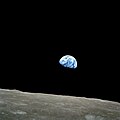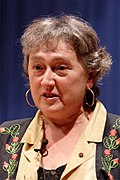Gaia hypothesis
Gaia Hypothesis
The Gaia Hypothesis, also known as Gaia Theory or Gaia Principle, proposes that organisms interact with their inorganic surroundings on Earth to form a synergistic and self-regulating, complex system that helps to maintain and perpetuate the conditions for life on the planet. The hypothesis was formulated by James Lovelock, a British scientist, and co-developed by Lynn Margulis, an American biologist, in the 1970s. It is named after Gaia, the ancient Greek goddess of the Earth.
Overview[edit]
The Gaia Hypothesis suggests that the Earth's biological systems and its abiotic components are closely integrated to form a single and self-regulating complex system, maintaining the conditions for life. This implies that the Earth itself can be viewed as a living entity, with the capacity to regulate critical environmental variables (such as climate and chemical composition of the atmosphere) to sustain life.
Development[edit]
The development of the Gaia Hypothesis was influenced by Lovelock's work with NASA on methods to detect life on Mars. Observing that Earth's atmosphere was in a highly improbable and chemically steady state, Lovelock theorized that this state was maintained by and for the biosphere. Lynn Margulis contributed significantly to the hypothesis with her work on the role of microorganisms in environmental processes, including the production and maintenance of oxygen in the atmosphere.
Components[edit]
The Gaia Hypothesis encompasses several key ideas:
- The Earth's living organisms and their inorganic surroundings have evolved together as a single living system that greatly affects the Earth's biochemical cycles.
- Life significantly alters the Earth's environment for the betterment of life, creating a homeostasis that supports life.
- Gaian regulation mechanisms include the carbon cycle, the sulfur cycle, and the nitrogen cycle, among others.
Criticism and Support[edit]
The Gaia Hypothesis has been both criticized and supported within the scientific community. Critics argue that it is teleological and lacks empirical support, suggesting that it does not conform to the principles of natural selection. Supporters, however, see it as a useful heuristic that highlights the interconnectedness of the Earth's systems.
Impact[edit]
The Gaia Hypothesis has had a profound impact on the fields of biology, earth science, and environmental science, encouraging interdisciplinary research into how the Earth's biosphere and abiotic components interact. It has also influenced environmental movements, contributing to a holistic view of Earth's environment.
See Also[edit]
References[edit]
<references/>

This article is a environment-related stub. You can help WikiMD by expanding it!
-
The Earth seen from Apollo 17
-
Paleotemperature variations over time
-
Daisyworld model simulation
-
Vostok ice core data
-
Earthrise from Apollo 8
-
James Lovelock in 2005
-
Lynn Margulis
Ad. Transform your life with W8MD's Budget GLP-1 injections from $75


W8MD offers a medical weight loss program to lose weight in Philadelphia. Our physician-supervised medical weight loss provides:
- Weight loss injections in NYC (generic and brand names):
- Zepbound / Mounjaro, Wegovy / Ozempic, Saxenda
- Most insurances accepted or discounted self-pay rates. We will obtain insurance prior authorizations if needed.
- Generic GLP1 weight loss injections from $75 for the starting dose.
- Also offer prescription weight loss medications including Phentermine, Qsymia, Diethylpropion, Contrave etc.
NYC weight loss doctor appointmentsNYC weight loss doctor appointments
Start your NYC weight loss journey today at our NYC medical weight loss and Philadelphia medical weight loss clinics.
- Call 718-946-5500 to lose weight in NYC or for medical weight loss in Philadelphia 215-676-2334.
- Tags:NYC medical weight loss, Philadelphia lose weight Zepbound NYC, Budget GLP1 weight loss injections, Wegovy Philadelphia, Wegovy NYC, Philadelphia medical weight loss, Brookly weight loss and Wegovy NYC
|
WikiMD's Wellness Encyclopedia |
| Let Food Be Thy Medicine Medicine Thy Food - Hippocrates |
Medical Disclaimer: WikiMD is not a substitute for professional medical advice. The information on WikiMD is provided as an information resource only, may be incorrect, outdated or misleading, and is not to be used or relied on for any diagnostic or treatment purposes. Please consult your health care provider before making any healthcare decisions or for guidance about a specific medical condition. WikiMD expressly disclaims responsibility, and shall have no liability, for any damages, loss, injury, or liability whatsoever suffered as a result of your reliance on the information contained in this site. By visiting this site you agree to the foregoing terms and conditions, which may from time to time be changed or supplemented by WikiMD. If you do not agree to the foregoing terms and conditions, you should not enter or use this site. See full disclaimer.
Credits:Most images are courtesy of Wikimedia commons, and templates, categories Wikipedia, licensed under CC BY SA or similar.
Translate this page: - East Asian
中文,
日本,
한국어,
South Asian
हिन्दी,
தமிழ்,
తెలుగు,
Urdu,
ಕನ್ನಡ,
Southeast Asian
Indonesian,
Vietnamese,
Thai,
မြန်မာဘာသာ,
বাংলা
European
español,
Deutsch,
français,
Greek,
português do Brasil,
polski,
română,
русский,
Nederlands,
norsk,
svenska,
suomi,
Italian
Middle Eastern & African
عربى,
Turkish,
Persian,
Hebrew,
Afrikaans,
isiZulu,
Kiswahili,
Other
Bulgarian,
Hungarian,
Czech,
Swedish,
മലയാളം,
मराठी,
ਪੰਜਾਬੀ,
ગુજરાતી,
Portuguese,
Ukrainian





